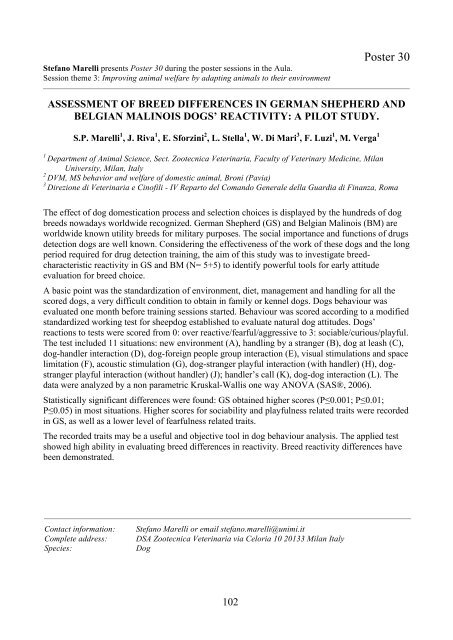Acknowledgements Book of abstracts - Publicaties - Vlaanderen.be
Acknowledgements Book of abstracts - Publicaties - Vlaanderen.be
Acknowledgements Book of abstracts - Publicaties - Vlaanderen.be
You also want an ePaper? Increase the reach of your titles
YUMPU automatically turns print PDFs into web optimized ePapers that Google loves.
Stefano Marelli presents Poster 30 during the poster sessions in the Aula.<br />
Session theme 3: Improving animal welfare by adapting animals to their environment<br />
102<br />
Poster 30<br />
ASSESSMENT OF BREED DIFFERENCES IN GERMAN SHEPHERD AND<br />
BELGIAN MALINOIS DOGS’ REACTIVITY: A PILOT STUDY.<br />
S.P. Marelli 1 , J. Riva 1 , E. Sforzini 2 , L. Stella 1 , W. Di Mari 3 , F. Luzi 1 , M. Verga 1<br />
1<br />
Department <strong>of</strong> Animal Science, Sect. Zootecnica Veterinaria, Faculty <strong>of</strong> Veterinary Medicine, Milan<br />
University, Milan, Italy<br />
2<br />
DVM, MS <strong>be</strong>havior and welfare <strong>of</strong> domestic animal, Broni (Pavia)<br />
3<br />
Direzione di Veterinaria e Cin<strong>of</strong>ili - IV Reparto del Comando Generale della Guardia di Finanza, Roma<br />
The effect <strong>of</strong> dog domestication process and selection choices is displayed by the hundreds <strong>of</strong> dog<br />
breeds nowadays worldwide recognized. German Shepherd (GS) and Belgian Malinois (BM) are<br />
worldwide known utility breeds for military purposes. The social importance and functions <strong>of</strong> drugs<br />
detection dogs are well known. Considering the effectiveness <strong>of</strong> the work <strong>of</strong> these dogs and the long<br />
period required for drug detection training, the aim <strong>of</strong> this study was to investigate breedcharacteristic<br />
reactivity in GS and BM (N= 5+5) to identify powerful tools for early attitude<br />
evaluation for breed choice.<br />
A basic point was the standardization <strong>of</strong> environment, diet, management and handling for all the<br />
scored dogs, a very difficult condition to obtain in family or kennel dogs. Dogs <strong>be</strong>haviour was<br />
evaluated one month <strong>be</strong>fore training sessions started. Behaviour was scored according to a modified<br />
standardized working test for sheepdog established to evaluate natural dog attitudes. Dogs’<br />
reactions to tests were scored from 0: over reactive/fearful/aggressive to 3: sociable/curious/playful.<br />
The test included 11 situations: new environment (A), handling by a stranger (B), dog at leash (C),<br />
dog-handler interaction (D), dog-foreign people group interaction (E), visual stimulations and space<br />
limitation (F), acoustic stimulation (G), dog-stranger playful interaction (with handler) (H), dogstranger<br />
playful interaction (without handler) (J); handler’s call (K), dog-dog interaction (L). The<br />
data were analyzed by a non parametric Kruskal-Wallis one way ANOVA (SAS®, 2006).<br />
Statistically significant differences were found: GS obtained higher scores (P≤0.001; P≤0.01;<br />
P≤0.05) in most situations. Higher scores for sociability and playfulness related traits were recorded<br />
in GS, as well as a lower level <strong>of</strong> fearfulness related traits.<br />
The recorded traits may <strong>be</strong> a useful and objective tool in dog <strong>be</strong>haviour analysis. The applied test<br />
showed high ability in evaluating breed differences in reactivity. Breed reactivity differences have<br />
<strong>be</strong>en demonstrated.<br />
Contact information: Stefano Marelli or email stefano.marelli@unimi.it<br />
Complete address: DSA Zootecnica Veterinaria via Celoria 10 20133 Milan Italy<br />
Species: Dog
















